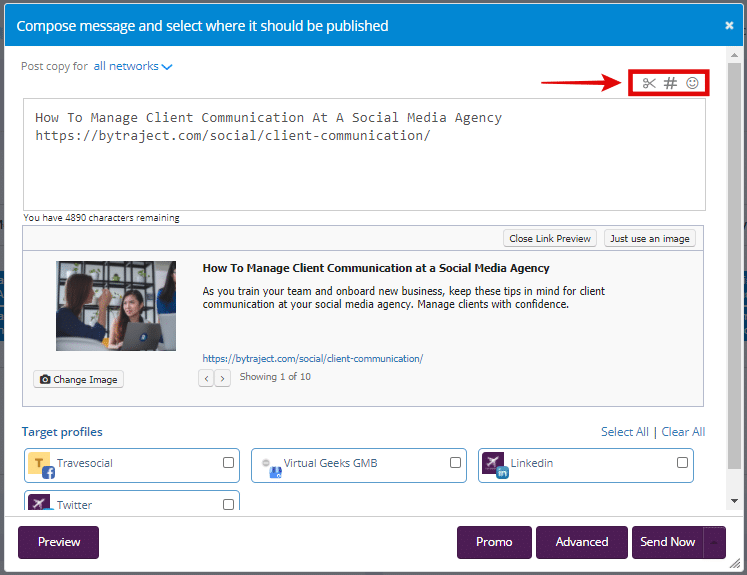It can feel like a full-time job to grow a following on Instagram.
With the addition of IGTV, Live Stories, and Instagram Reels, hashtags might seem like a tactic of the past.
You might even wonder, “Should I still use hashtags on Instagram?”
The answer is yes.
Using hashtags for business can help marketers increase brand reach and find completely new audiences.
Keep reading to find:
- The types of hashtags for business on Instagram
- Top tips for using hashtags for business promotion and social media marketing
Table of Contents
Start your free 14-day Fanbooster trial
What Are Instagram Hashtags?
Hashtags are relevant keywords preceded by a hash (#) symbol. Businesses use hashtags on social media platforms to help increase the searchability of their content.
In general, hashtags can’t include spaces, punctuation, or special symbols. You can only use letters, numbers, and emojis to create hashtags.
On Instagram, hashtags can be used in a variety of ways to make your content more discoverable.
People can click on hashtags to see other content with that tag. Users on Instagram can also follow hashtags the same way they follow other accounts.
You can use hashtags for business on your:
Post captions (all types)
Instagram Stories
Comments
Instagram profile

There are also nine types of hashtags for Instagram.
Types of Hashtags for Instagram
- Acronym hashtags: Acronym hashtags abbreviate common phrases into an acronym. Examples include #OOTD (outfit of the day), #WCW (woman crush Wednesday), and #TBT (throwback Thursday).
- Daily hashtags: Several hashtags are dedicated to specific days of the week, like #SundayFunday or #WineWednesday.
- Emoji hashtags: While most hashtags can’t include symbols, Instagram hashtags can include emojis. This creative hashtag can be just emojis, or it can consist of words and numbers.
- Industry or community hashtags: Instagram has several communities of people who follow similar interests and related hashtags. They can be found by using hashtags like #FoodiesofInstagram or #PhotographersofNewYork.
- Location hashtags: Location hashtags can be used in conjunction with a geotag on your posts and Stories. A location hashtag can be just the location, such as #Chicago, or it can specify an interest, like #BikeAtlanta.
- Niche hashtags: Niche hashtags are used to specify your area of expertise or specialization like #bloggers, #torontochef, or #motivationalquotes.
- Product (or service) hashtags: Product and service hashtags specify your offerings, such as #backpack, #skincare, or #lifecoach.
- Special event/seasonal hashtags: Special event hashtags can indicate holiday-specific content like #nationaldonutday or #valentinesday. Seasonal hashtags can be used for general seasons like #WinterWonderland and #SummerVacation.
Finding the Right Hashtags for Business Growth
When you use hashtags for business, the best place to start is with your audience. First, identify your ideal customer demographics.
Consider qualities like age, gender, interests, and geographics. As you narrow down your target audience, relevant hashtags may begin to appear.
Take some time to look at your existing followers’ accounts and see if they regularly engage with specific hashtags.
Next, think about your product (or service) and your brand.
Ask yourself the following questions:
- Are there existing hashtags related to my product?
- What keywords do I want to have associated with my brand?
- Which communities can my brand benefit from joining?
- Does my brand stand for social causes or values?
Create a list of keywords associated with your brand and start by searching them on Instagram. The search bar will populate with commonly used hashtags and tell you how many posts have that hashtag.

Finally, take a look at influencers in your industry and your competitors. Doing so can help you find more specific hashtags and narrow your audience.
How to Save Hashtags on Instagram

If you have found a list of hashtags you want to reuse, you can simply copy and paste them into a notes app or marketing document. Alternatively, you can use tools like Fanbooster’s Hashtag or Snippet Feature to easily add popular hashtag combinations to your Instagram posts.
The Snippet feature allows you to create snippets of any text and/or hashtags that you want to reuse in future posts. Here’s how to create a Snippet:
How to Create a Text Snippet
- Click on the scissors icon in the composer window
- Click Create Template, add a title and text template
- Save the template
- Use the snippet by clicking on it. The text will automatically be inserted to your post
The Hashtag feature will allow you to reuse past hashtags and hashtag combinations, as well as show you popular hashtags that are currently trending.
How to Access Hashtags
- Click on the hashtag icon in the composer window
- Choose one of three options
- Hashtags: hashtags you’ve recently posted to social media
- Combinations: collection of hashtags commonly grouped together. Click edit to add a title of the hashtag combination.
- Most Popular: trending hashtags on social media
- Click on the hashtag(s) you want to use, and it will automatically be inserted into your post
Using Hashtag Generators
Manually doing a hashtag search takes a lot of time.
The good news?
Top social media schedulers include access to business hashtag generators that help you identify your best marketing hashtags.
If you’re not using a social media scheduler yet, you can still find hashtag generators online, such as all-hashtag.com or displaypurposes.com.
You can use hashtag generators to create lists of popular Instagram hashtags or explore hashtags similar to those you already use.
Hashtags for Business Promotion: Best Practices
As with any other marketing tactic, there are right and wrong ways to use hashtags.
When used correctly, a hashtag campaign can help you grow your reach on Instagram and establish your brand identity.
Here are some of the best practices for using hashtags for Instagram:
- Don’t use too many hashtags. You can use up to 30 hashtags per Instagram post and 10 per Instagram Story. However, using too many hashtags can appear spammy. Most posts and stories contain one to three hashtags , but this includes all account types. Many sources claim that using 11 hashtags is the sweet spot for businesses.
- Keep your hashtags short. Hashtags should be short and easy to read. Your users won’t click on them if they’re difficult to comprehend. Studies found that 21-24 characters are the most popular length of hashtags. You can also use capital letters to make words or phrases more readable.
- Find creative hashtags and branded hashtags. Although you should tap into popular or trending hashtags, get creative to find less competitive hashtags. It also helps to brainstorm new hashtags specific to your business to encourage your customers to engage with your brand.
- Change up your hashtags. While it’s easier to reuse the same hashtags, Instagram might recognize this as spammy behavior. Try to change up at least one or two hashtags for each post, so you always use the most relevant hashtags.
- Take time to do research. Like search engine optimization (SEO), your hashtag campaigns are only as good as your research. The key is to stay focused. Try to be more specific when you have the chance. You may need to use different hashtags for different types of customers.
- Find a mix of hashtag sizes. When you create a list of hashtags for business promotion, include hashtags with different follower sizes. For example, you can use hashtags with over a million posts along with hashtags that only have posts in the thousands.
Final Thoughts: How to Use Hashtags for Business Growth on Instagram
Instagram is an excellent platform to grow brand awareness and find new customers.
In particular, finding the best hashtags for business helps your posts reach a larger and more targeted audience with your marketing strategy.
For more information about scheduling your social media posts, explore Fanbooster today.



